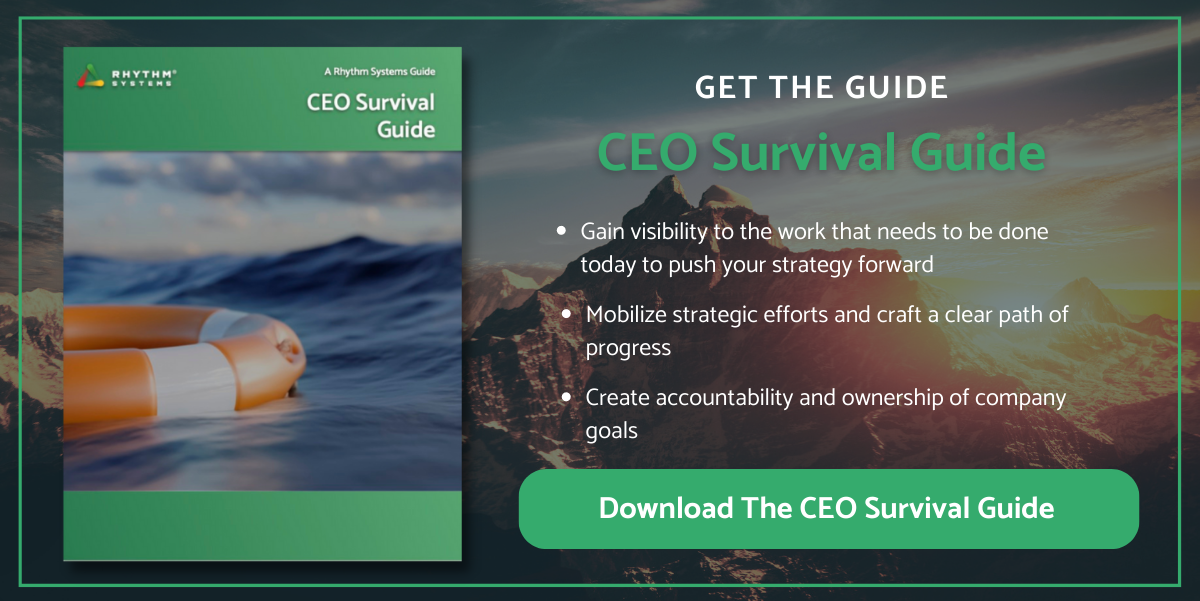Businesses must balance demands, juggle multiple tasks, and make tough decisions to succeed. However, without the right strategies and processes, even the most promising companies can be derailed by disorganized spreadsheets, misalignment between departments, unproductive meetings, and a lack of organizational talent.
For CEOs and their executive teams to unleash their full potential – personally and professionally – it's essential that organizations get a handle on these issues. Doing so will pay off long-term dividends regarding strategic planning and organizational effectiveness.
How CEOs Move From Chaos to Clarity
Establish Visibility into Goals:
Establishing companywide visibility into goals is essential for all stakeholders to understand their specific roles in achieving success. Setting clear objectives creates alignment between departments and builds trust within the organization.
Rhythm Systems Strategy Execution System is an innovative approach that helps CEOs transform their organizations from chaos to clarity. It puts structure and clear guidelines around planning, execution, and tracking results that drive maximum organizational performance. This method helps align teams, engage executive sponsors, identify gaps quickly, ensure accountability on tasks and outcomes that matter most, and provides early warning signals when priorities shift, or urgent problems arise.
Alignment To A Clear Strategic Plan:
Alignment to a clear strategic plan is essential to move from chaos to clarity. A strategic plan provides the roadmap for how an organization will achieve its goals and objectives. It outlines the strategies, tactics, and resources needed to reach those goals. By aligning the organization's activities with this plan, CEOs can ensure that everyone is working towards the same end goal.
Create A Culture Of Strategy Execution:
Creating a culture of accountability is essential to move from chaos to clarity. Accountability means that everyone in the organization is responsible for their actions and results. It also means that everyone is held accountable for their performance and that there are consequences when goals are not met. This helps ensure that all stakeholders are working together towards the same objectives, and it creates
An aligned plan makes execution smooth, as each management level has insight into what's happening throughout the system. When teams have a unified view of where they want to go as an organization, people feel more engaged in driving business value instead of punching in numbers on spreadsheets daily.
Efficiency Vs. Effectiveness:
Efficiency and effectiveness are two crucial concepts for CEOs to consider when moving from chaos to clarity. Efficiency is the ability to do something quickly and with minimal effort, while effectiveness is achieving a desired result. Both of these concepts are essential for successful strategy execution.
Efficiency is important because it allows leaders to get more done in less time, which can help them move from chaos to clarity faster. However, effectiveness is also significant because it ensures that the organization achieves its desired results.
Too often, business efficiency is mistaken for effectiveness; one should not be confused with the other but instead treated as complementary muscles which work together towards the success of any company or individual in leadership positions who wish reach those goals faster without losing focus at larger scale operations longer term viable wins are achieved through effective plans that are executed efficiently over time while allowing room for adaptation with flexibility along the way.
Dashboards & Increasing Accountability:
High-level dashboards are essential to move from chaos to clarity. Dashboards provide a comprehensive overview of the organization's performance, allowing CEOs to identify areas of improvement and take action quickly. With the right dashboard, they can easily track key performance indicators (KPIs) and compare them against goals. This helps them decide where to focus their efforts and resources.
Utilizing high-level dashboards helps simplify data analysis while providing clear targets that allow every employee—from front-line staff members up to senior executives—the ability to increase awareness of different objectives have on companywide performance a significant view perspective. This helps to ensure that everyone is held accountable for their individual contributions, leading to better execution and improved results.
Meeting Deadlines & Cash flow Requirements
Meeting deadlines and cash flow requirements are two of the most critical elements of a successful business strategy. CEOs must ensure their teams meet deadlines and manage cash flow to achieve their goals. To do this, they must have a system that allows them to track progress, set expectations, and hold people accountable for results.
One of the critical aspects of ensuring ongoing operational health means adhering to timeline deadlines proactively when dealing service delivery process or working through the list of services provided; having x number of days allotted to finish the collaboration effort, any gaps missed identifying course might lead to inevitable situations and need to assess why happened then formulate adequate measure recovery quickly possible also regularly manage to check cash flows needs appropriately handle any money related problems cash flows the vast majority of businesses fail due incorrect assumptions, or miscalculations keep records updated status monitor thereby preparing recession cyclically aware competitive marketplace realistically informed prepares us best ahead period instability unknown variables.
By implementing these critical processes, organizations can drive better outcomes by enjoying increased efficiency and effectiveness from employees at all levels while connecting strategic planning overarching organizational vision -- resulting in collaborative comment threading tasks accountable manner, maximizing chances to outperform annual competition plan propels confidence customers know linkages deliverables expects adapts turns gives you capability adjusting feedback gathered necessary achieving delight exceeding expectations measured results deliverables times.
For more information, learn from these popular blogs:
- Why an Execution System Can Drive Your Strategy and Get You Results
- Strategy vs Execution: Don't Confuse Strategic Thinking and Strategy Execution
- Company Alignment: The CEO's Roadmap to Business Alignment
- Your Journey to Great Strategic Execution in 2023
- 5 of the Top-Rated Features of the World’s Best Strategy Execution Software





